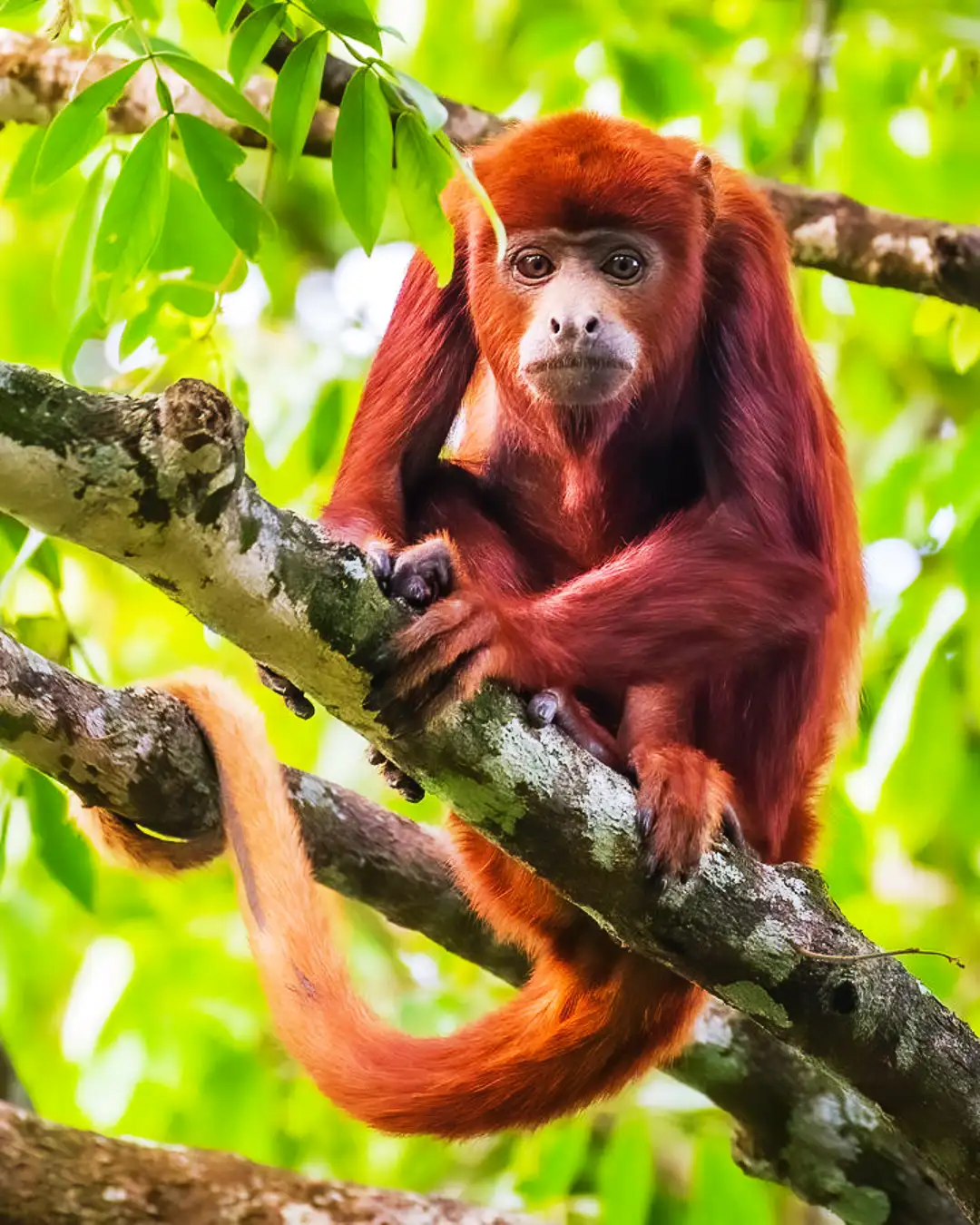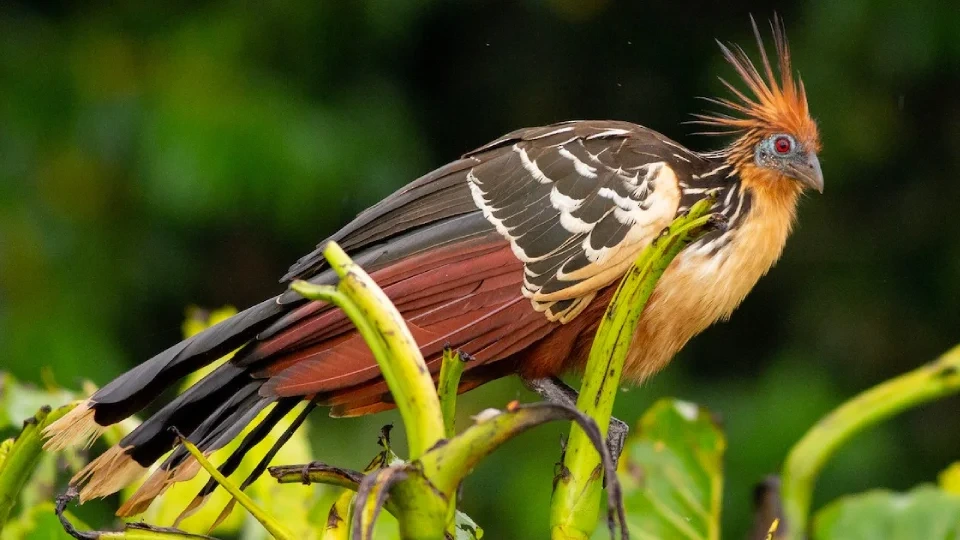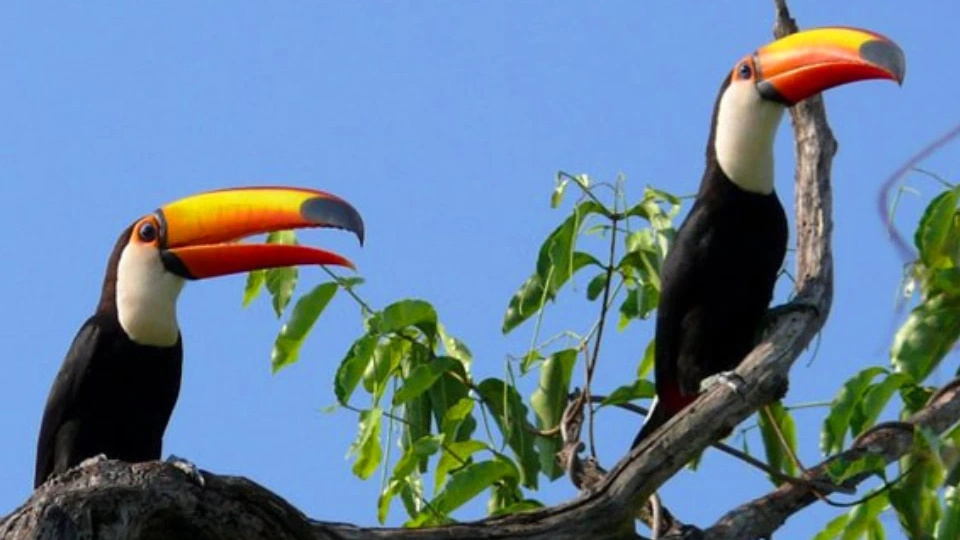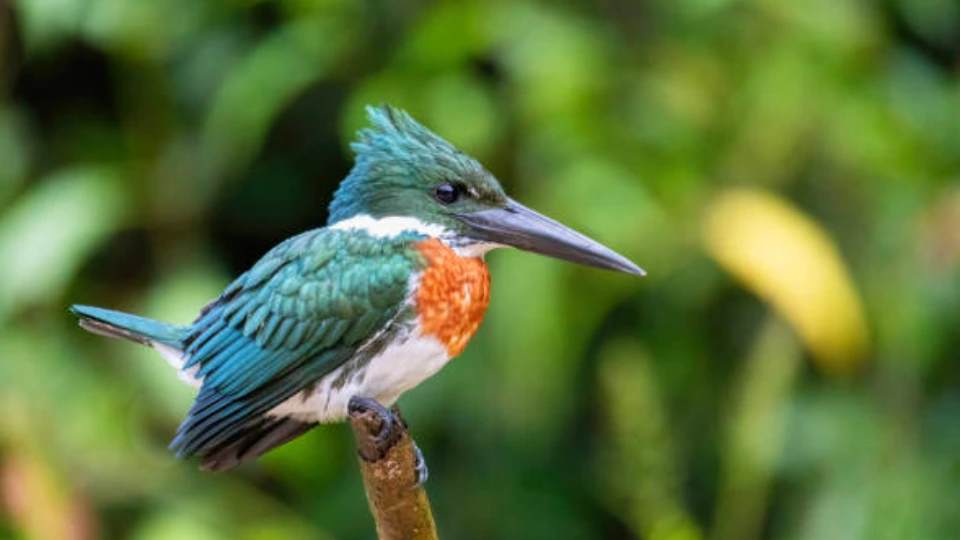The Peruvian Amazon is located in the heart of South America. It is a faithful evidence of the beautiful balance of life that takes you through the thick jungle where species, from mammals to insects, coexist in complete harmony. Join us on this blog and meet the Amazon rainforest animals.
Imagine that you are deep in the Amazon; all around you, the trees tower above you, and the humidity of the air permeates your lungs; in the distance, the song of birds, the buzz of insects, and the rustling of leaves fill your ears. Suddenly, you see a jaguar lurking in the undergrowth, noticing its spotted fur blending into the shadows. Now imagine waking up and realizing this is just a glimpse of all the hidden magic the Amazon rainforest in Peru has to offer.
Mammals of the Peruvian Amazon rainforest
When we hear the words Amazon rainforest, our imagination travels through a vast universe of diverse animals ranging from playful mammals like the capuchin monkey to exotic birds like the macaw or peculiar insects like the Goliath bird-eater. They all have in common that they have known how to enter the dense jungle and have made the Amazon their only home.
Jaguar (Panthera onca)
Although the jaguar is considered the largest and most dangerous feline in America for being an avid and influential predator, its presence in the Amazon rainforest allows other species to be protected in order to maintain the ecosystem in balance. Jaguars usually stay on the ground, but they are excellent tree climbers, as well as swimmers; these skills allow them to hunt other terrestrial mammals, such as capybaras, tapirs, and deer, or aquatic animals, such as turtles and fish, among others.
Capybara (Hydrochoerus hydrochaeris)
The capybara is the largest rodent in the world, looking like an oversized guinea pig and weighing up to 90 kilos. Calm and social, it lives in family groups along rivers and lakes of the Peruvian jungle. Semi-aquatic and herbivorous, it feeds on grass and aquatic plants, often resting in the water to cool down and escape predators, a favorite subject for wildlife photos in the Amazon.
Amazon River Dolphin (Inia geoffrensis)
The Amazon River dolphin, or Boto, is famous in local legends and is easy to recognize by its pink color and long snout. Living in the flooded forests and calm channels of the Amazon rainforest in Peru, it often appears near quiet river bends. Sadly, this intelligent dolphin is threatened by hunting, fishing nets, and pollution, so respectful boat tours are key to protecting it in the Amazon rainforest.
⏭️Read more: Amazon Pink River Dolphin
Howler Monkey (Alouatta Seniculus)
Howler monkeys are among the loudest Amazon rainforest animals; their deep calls can be heard for kilometers at dawn and dusk. Males are mostly black, while females range from reddish to yellow. They eat leaves, fruits, and flowers high in the canopy of the Amazon rainforest, living in family groups that guides usually locate by sound before helping visitors spot them against the sky.
Giant otter (Saimiri vanzolinii)
The giant otter can reach two meters in length, making it the largest otter in the world. It lives in tight-knit family groups in lakes and river channels of the Peruvian Amazon rainforest, hunting fish, crustaceans, and even small caimans. Listed as endangered, it is one of the most exciting rainforest animals to watch, often announced by splashes, calls, and ripples on quiet oxbow lakes.
Black-headed squirrel monkey (Saimiri vanzolinii)
The black-headed squirrel monkey is a tiny primate with a tail longer than its body and a dark cap on the head. Weighing under 800 grams, it moves quickly through the trees of the Peruvian Amazon rainforest in noisy groups that can reach dozens of individuals. Always on the move, these curious Amazon rainforest animals search for insects, fruits, and flowers while chattering above jungle trails.
Collared anteater (Tamandua mexicana)
The collared anteater is a smaller relative of the giant anteater, measuring around 60 cm plus a long tail. With strong claws and a sticky tongue, it tears into termite mounds and rotten logs to eat ants, termites, larvae, and honey. Mostly nocturnal in the Amazon, it is hard to spot, but travelers sometimes see one resting in trees or find its footprints along quiet jungle trails.
The bearded emperor tamarin (Saguinus imperator subgrisescens)
The bearded emperor tamarin is a small monkey known for its long white mustache, a slim body of about 25–30 cm, and a long tail. Feeding on fruits, insects, and nectar, it travels in family groups through the mid-level canopy of the Amazon rainforest in Peru. Its expressive face makes it one of the most photogenic animals to spot during walks and boat excursions.
Puma (Puma concolor)
The puma is a solitary, adaptable cat that can reach 150 cm in length and over 30 kilos in weight. An agile hunter of deer, capybaras, and other mammals, it moves between the Amazon rainforest, cloud forests, and high Andean grasslands. Mostly active at night, it is rarely seen by visitors, though camera traps in protected areas of the rainforest in Peru often capture its silent movements.
Amazonian tapir (Tapirus terrestris)
The Amazonian tapir, or lowland tapir, is the largest land mammal in South America, with a sturdy body, brown fur, and a short, flexible snout. Living along rivers and the swampy forests of the Amazon, it eats grasses, leaves, shoots, fruits, and aquatic plants. As an important seed disperser in the Amazon rainforest, it helps new trees grow and supports supports many other rainforest animals and plants.
Manatees (Trichechus inunguis)
The Amazonian manatee is a gentle aquatic mammal, a bit like a mix between a seal and a small hippo. It lives in calm white- and black-water rivers below 300 meters of altitude in the Peruvian Amazon rainforest, feeding on grasses and floating plants such as water lettuce and grama lote. Sadly, hunting has reduced its numbers, so community projects in the Peruvian jungle work hard to protect this peaceful herbivore.
Birds of the Peruvian Amazon rainforest
Going into the Amazon rainforest is not only about seeing terrestrial and aquatic life or majestic forests; it is also about looking up to find just a few of the 1,300 species of birds that live in the dense jungle. Thanks to conservation and awareness plans, government administrators such as SERNANP (National Service of Natural Protected Areas of Peru) have managed to help many of these birds overcome the status of "Endangered Species" in Peru.
Harpy eagle (Harpia harpyja)
The harpy eagle is one of the largest birds of prey in the world and a top predator of the Amazon rainforest. With powerful claws and wings, it can snatch monkeys, sloths, and large birds from the canopy, and even small deer. It nests high in giant trees and needs vast territories, so its presence is a sign of a healthy forest. Spotting one in the Amazon rainforest in Peru is rare, making it a dream sighting for fauna lovers.
Scarlet macaw (Ara macao and Ara chloropterus).
Scarlet macaws are the brightly dressed queens of the jungle, with red, yellow, and blue feathers that light up the canopy. In the jungle, they often fly in noisy pairs or gather at clay licks to eat mineral-rich soil that helps them digest seeds, fruits, and nuts. They can live 30–50 years in the wild and even up to 75 years under human care, and are loyal partners and key seed dispersers.
Hoatzin (Opisthocomus hoazin)
The hoatzin is a strange, prehistoric-looking bird with a spiky crest and blue face that lives along rivers, lakes, and flooded forests of the Peruvian Amazon. Its diet is mostly young leaves and buds, which it ferments in a special stomach, giving it a strong odor. Hoatzins move clumsily in the branches and often form noisy groups, becoming easy prey for larger predators.
Toco toucan (Ramphastos toco)
The toco toucan is one of the most famous Amazon rainforest birds. It can weigh 500 grams and measure 56 cm. It is easily recognized by its huge, colorful bill, which can reach more than 20 cm. This light but strong beak helps it reach fruits on thin branches and also eat insects, eggs, and small vertebrates. Often seen in pairs or small groups in the treetops, toucans help spread seeds and add color to the Amazon rainforest.
Amazonian kingfisher (Chloroceryle amazona)
The Amazonian kingfisher is a green and white bird that lives along rivers and streams of the Peruvian Amazon rainforest. It measures between 29 and 30 cm and weighs approximately 110 grams. Perched on branches above the water, it waits patiently before diving headfirst to catch small fish, insects, and aquatic invertebrates with its sharp bill. If you travel by boat, you can often watch this fast hunter flying low over the water or calling from exposed perches.
Cock-of-the-rock (Rupicola peruvianus)
The cock-of-the-rock is an iconic bird declared the National Bird of Peru in 1947, known for the male’s bright orange-red plumage and half-moon crest. Females are brown and better camouflaged, a characteristic of their sexual dimorphism. These birds live on humid cliffs and ravines between 500 and 2,500 m, where males gather at leks to dance and call to attract mates. Feeding mainly on fruits, they are excellent seed dispersers.
Paradise Tanager (Tangara chilensis)
The Paradise Tanager is a small, multicolored bird that looks like a flying rainbow, with a green head, blue belly, and dark wings. It measures 13 to 15 cm and weighs 20 grams. Found high in the canopy of the Peru rainforest, it often joins mixed flocks of other animals to search for fruits and insects. Its bright colors are easiest to see with binoculars on clear mornings along forest edges and riverbanks.
Potoo Bird (Nyctibius griseus)
The potoo bird is a master of camouflage among Amazon rainforest animals. It measures between 25 and 58 cm and can weigh 250 grams. With brown, mottled feathers and a stiff posture, it looks exactly like a broken branch during the day. At night, it becomes active, using its huge mouth to catch moths, beetles, and other flying insects. In the Peruvian Amazon, guides often point out resting potoo that most visitors would otherwise miss.
Reptiles of the Peruvian Amazon rainforest
Within the vast diversity of animal life that we can find in the Amazon rainforest, reptiles are just a tiny part of this immeasurable world.
Green Anaconda (Eunectes murinus)
The green anaconda is one of the largest snakes on Earth, with females often surpassing 6 m in length and living in swamps and slow rivers of the jungle in Peru. This powerful constrictor is an expert swimmer but also moves on land, hunting fish, aquatic birds, reptiles, and mammals such as capybaras, making it one of the most impressive Amazon rainforest animals of the Peruvian Amazon.
Black Caiman (Melanosuchus niger)
The black caiman is a massive reptile that can grow close to 6 m, with dark armor-like skin that sets it apart from other crocodilians of the Amazon rainforest. It usually waits silently at river edges, ambushing deer, capybaras, tapirs, and large fish. As one of the top predators of the jungle, it must be respected and observed only with experienced local guides.
Emerald boa (Corallus batesii)
The emerald boa is a striking tree-dwelling snake with bright green scales and white markings that help it blend into the canopy of the Peru rainforest. Usually measuring around 1.5 m, it coils on branches above forest trails, waiting to ambush birds, amphibians, and small mammals. Night walks in the Amazon rainforest often give visitors a chance to spot this beautiful but shy predator.
Iguana (Iguana iguana)
The green iguana is one of the most familiar rainforest animals, reaching up to 2 m in length and weighing 15 to 17 kilos, including its long tail. Common along riverbanks and in sunny treetops of the Peruvian Amazon, this herbivorous reptile feeds on leaves, flowers, and fruits. It can regrow broken tail sections and even replace lost teeth, helping it survive in the dynamic environment of the jungle.
Yellow-spotted river turtle (Podocnemis unifilis)
The yellow-spotted river turtle is easy to recognize by the yellow marks on the sides of its head. Females can be almost twice the size of males; males measure about 40 cm, while females can reach 80 cm, and nest on sandy riverbanks at the start of the dry season. Omnivorous and long-lived, they eat fish, crustaceans, grasses, and fruits, playing an important role in the balance of the Amazon rainforest in Peru.
Amphibians of the Peruvian Amazon Rainforest
The Amazon rainforest is a paradise for amphibians, as its warm, humid environment provides the perfect habitat for these creatures. From brightly colored frogs to stealthy salamanders, Amazon amphibians are as diverse as they are fascinating.
Poison Dart Frog (Phyllobates terribilis)
The poison dart frog is one of the most toxic animals on Earth despite its tiny size, which can reach up to about 2.5 cm and 28 grams. A single frog can carry enough poison to kill several people. In the wild of the Amazon rainforest, its bright colors warn predators to stay away. Its toxins are thought to come from its jungle diet of ants, termites, crickets, flies, and beetles.
Amazonian tree frog (Hypsiboas picturatus)
The Amazonian tree frog can reach about 8 cm, with females larger than males, with a long, wide head and skin that is rough in males and smoother in females. It lives high on leaves and branches near streams in the Peruvian Amazon rainforest. They have grayish or yellowish tones that provide camouflage. At night, it hunts insects, beetles, and flies, helping control many small pests in the Amazon rainforest.
Glass frog (Hyalinobatrachium yaku)
The glass frog is a tiny amphibian discovered only recently in the Amazon rainforest, famous for its transparent belly that reveals its organs and even its beating heart. Adults measure just over 2 cm and live on leaves above streams. In many species, males guard the eggs that females lay on the underside of leaves, protecting them from predators and keeping them moist until they hatch.
Cane Toad (Rhinella Marina)
The cane toad is a large, toxic toad that can reach 10–15 cm and weigh 2.7 kg. Common in disturbed areas of the Peruvian Amazon rainforest, it has dry, warty skin and large poison glands behind the eyes. When threatened, it releases a milky toxin that can kill pets and wild predators. It eats almost anything: beetles, insects, spiders, carrion, and even smaller toads.
Salamander (Bolitoglossa altamazonica)
This Amazon rainforest salamander has a slender body, long tail, and short limbs, moving quietly among wet leaves and rotting logs. Its brown shades help it blend into the forest floor of the Peruvian Amazon. Unlike many amphibians, it has no lungs and breathes through its moist skin. It feeds on ants, spiders, beetles, centipedes, termites, and small snails during humid nights.
Insects of the Peruvian Amazon Rainforest
Even the smallest and most invisible animal is necessary in the Amazon rainforest, and insects play an essential role in pollinating and decomposing dead animals.
Bullet ant (Paraponera clavata)
The bullet ant fully lives up to its name: its sting is often described as one of the most painful in the animal world, so much so that its pain is similar to that caused by a bullet in the body. This large Amazon rainforest ant builds nests at the base of trees and defends them fiercely. It is omnivorous and feeds on nectar, plant sap, small insects, and bits of fruit, playing an important role in recycling nutrients on the damp forest floor.
Blue morpho butterfly (Morpho peleides)
The blue morpho butterfly is one of the most iconic insects of the Amazon rainforest. With a wingspan that can reach about 20 cm, its bright blue wings flash like mirrors of the sky as it flies along rivers and trails. Adults live only about three months and feed mainly on rotting fruit and nectar, while habitat loss and illegal collecting threaten some populations.
Leaf-cutter ant (Atta sexdens)
Leaf-cutter ants are famous engineers of the Amazon rainforest. Workers measuring 1–2.5 cm cut and carry leaf pieces many times their own weight back to underground nests, where a queen of about 5 cm can live for up to 20 years. Instead of eating the leaves directly, they use them to grow a special fungus, which is their real food and helps enrich the forest soil.
Bird-eating tarantula (Theraphosa blondi)
The bird-eating tarantula, or Goliath birdeater, is one of the largest spiders on Earth, with a leg span of up to 30 cm. Despite its name, it usually hunts insects, worms, and small vertebrates like frogs or mice on the Amazon rainforest floor at night. Its venom is not usually deadly to humans, but its size, fangs, and defensive hairs make it an impressive predator to encounter.
Assassin bug (Reduvius personatus)
Assassin bugs are a diverse family of more than 7,000 species in the Amazon rainforest, known for their powerful, curved mouthparts. They use a long beak to inject venomous saliva that paralyzes and liquefies the insides of their prey, which can include cockroaches, fleas, nymphs, and other insects. Many live on leaves and tree trunks, acting as stealthy predators.
Peanut-headed bug (Fulgora laternaria)
The peanut-headed bug gets its name from its strange, peanut-shaped head with large false “eyes” that help scare predators in the Amazon rainforest. Measuring up to 9 cm in total, it rests on tree trunks during the day and feeds on sap from certain plants using its long mouthparts. When threatened, it can open its patterned wings and release an unpleasant smell as an extra defense.
Cocoon moth (Urodida teje)
Urodidae cocoon moths are small, little-known Amazon rainforest insects recognized by the curious hanging cocoons their larvae build under leaves. The caterpillar weaves a delicate, elongated case and then pupates inside, protected from many predators. On warm, humid nights, the newly emerged adult moths can sometimes be seen resting near the empty cocoons.
Fish of the Peruvian Amazon Rainforest
The rivers and lakes of the Amazon rainforest are teeming with fish, many of which are found nowhere else on Earth. From the infamous piranha to the massive arapaima, the fish of the Amazon are as unique as they are fascinating.
Arapaima (Arapaima gigas)
Also known as pirarucu, it is considered the largest river fish. It is found throughout the Amazon and can be seen in the Madre de Dios River in Peru. It can measure up to 3 meters in length and weigh 250 kilos. Its diet is based on fish, seeds, fruits, and insects. It can also jump at high speed from rivers and catch birds near the surface and occasionally small mammals that come too close to the water’s edge.
Piranhas (Pygocentrus nattereri)
Red-bellied piranhas are iconic Amazon rainforest animals, famous for their sharp, triangular teeth and strong jaws. Growing 15–25 cm and about 300 g, they swim in groups along rivers and flooded forests of the Peruvian Amazon rainforest. Despite their scary movie image, they are mostly omnivores and scavengers, feeding on fish, insects, fruits, seeds, and animal remains.
Electric Eel (Electrophorus electricus)
The electric fish of the Amazon is a spectacle of nature. It is capable of making electric discharges of 700 watts and two amps. It can measure between 2 and 2.5 meters in length and is brown to green in color. It has a habit of coming to the surface to swallow air. The eel is a carnivorous fish that feeds on fish, crustaceans, worms, aquatic insects, and mollusks, among other things.
Red-bellied pacu (Piaractus brachypomus)
The red-bellied pacu is often mistaken for a piranha, but this Amazon rainforest fish is mainly herbivorous. Common in lakes and calm rivers of the Peruvian Amazon, it has strong, square teeth that crush hard Brazil nuts, seeds, and fruits that fall into the water. Pacu may also eat leaves and small fish, helping disperse seeds and keeping the waterways of the Amazon rainforest in Peru full of plant life.
Where to See Amazon Rainforest Animals in Peru?
| Reserve | Location | Description | What animals can you see? |
| Tambopata National Reserve | Madre de Dios region, southeastern Peru, in the districts of Tambopata and Inambari near Puerto Maldonado. | A very accessible slice of the Peruvian Amazon rainforest with oxbow lakes, river beaches, and clay licks. Tambopata shelters hundreds of bird and mammal species, including healthy populations of large predators, making it perfect for short but wildlife-rich jungle trips. |
|
| Manu National Park | Western Amazon basin, spanning Cusco (Paucartambo) and Madre de Dios (Manu), from the Andean highlands down to lowland rainforest. | A UNESCO World Heritage Site and one of the most biodiverse places on Earth. Manu protects a full altitudinal gradient from cloud forest to lowland jungle, offering a truly immersive, multi-day experience for travelers who want remote, pristine Peruvian Amazon rainforest. |
|
| Pacaya Samiria National Reserve | Loreto region in northern Peru,between the Marañón and Ucayali rivers, accessible mainly from the town of Nauta near Iquitos. | Known as the “jungle of mirrors,” Pacaya Samiria is Peru’s largest protected flooded forest, a world of blackwater rivers, lagoons, and seasonally inundated jungle. It’s a classic destination for Amazon River cruises focused on wildlife watching and community-based conservation. |
|
| Allpahuayo Mishana National Reserve | Loreto region, Maynas province, just southwest of Iquitos, along the Iquitos–Nauta road and the Nanay River. | A compact but incredibly diverse reserve protecting rare white-sand forests of the Peruvian Amazon. Easy to reach from Iquitos, it’s a top spot for birdwatchers and nature lovers who want to explore unusual habitats filled with endemic plants, birds, amphibians and insects. |
|
⏭️Read more: Manu National Park
How to get to know the Amazon rainforest in Peru
If you've come this far fascinated by the Amazon rainforest animal tour, imagine how much excitement you would feel if you were seeing these beautiful animals up close. Come with us to explore the Amazon rainforest in Peru. We offer different alternatives; choose the one that best suits you.
A.- Choose a base camp
Some travelers begin their journey through the Amazon in Iquitos or Puerto Maldonado, two cities that give you access to the Peruvian Amazon. From here, you can embark on guided tours or stay in ecolodges that give you a base to explore the jungle.
B.- Take a boat ride
Like traveling through Venice by gondola but with imposing nature around, a river cruise along the Amazon and its tributaries offers you a unique perspective of the rainforest. In addition, you will have the opportunity to observe wildlife, visit remote villages, and explore the canals that run through the jungle.
C.- Join a guided tour
Guided tours are one of the best ways to explore the Amazon. You will have an expert guide at your disposal who will gladly give you details about wildlife while informing you about ecological measures to keep the jungle ecosystems healthy. You will be safe at all times. Many tours also offer specialized activities, such as bird watching, night walks, and fishing.
D.- Stay in an eco-lodge
Eco-lodges are undoubtedly a great alternative that allows you to comfortably and sustainably explore the Amazon. These lodges are usually located in remote areas, which will guarantee you a magical and unique experience in the heart of the jungle.
E.- Respect the environment
Remember that when you visit the Amazon, it is very important that you reduce your impact on the environment by following the principles of leaving no trace, avoiding disturbing wildlife, and supporting ecological practices.
When exploring the Amazon rainforest in Peru, you will witness the incredible diversity of life that thrives in this unique ecosystem. Whether you spot jaguars in the jungle, listen to the calls of howler monkeys, or marvel at the vibrant plumage of macaws, the Amazon offers an experience like no other.
The jungle may be dense and mysterious, as a nature lover don't forget to be patient and wait to see all that this world of life, beauty and wonders has to offer, always from a safe distance without interrupting the life cycle of the Peruvian Amazon.
"The love for all living creatures is the most noble attribute of man." - Charles Darwin




















































Add new comment